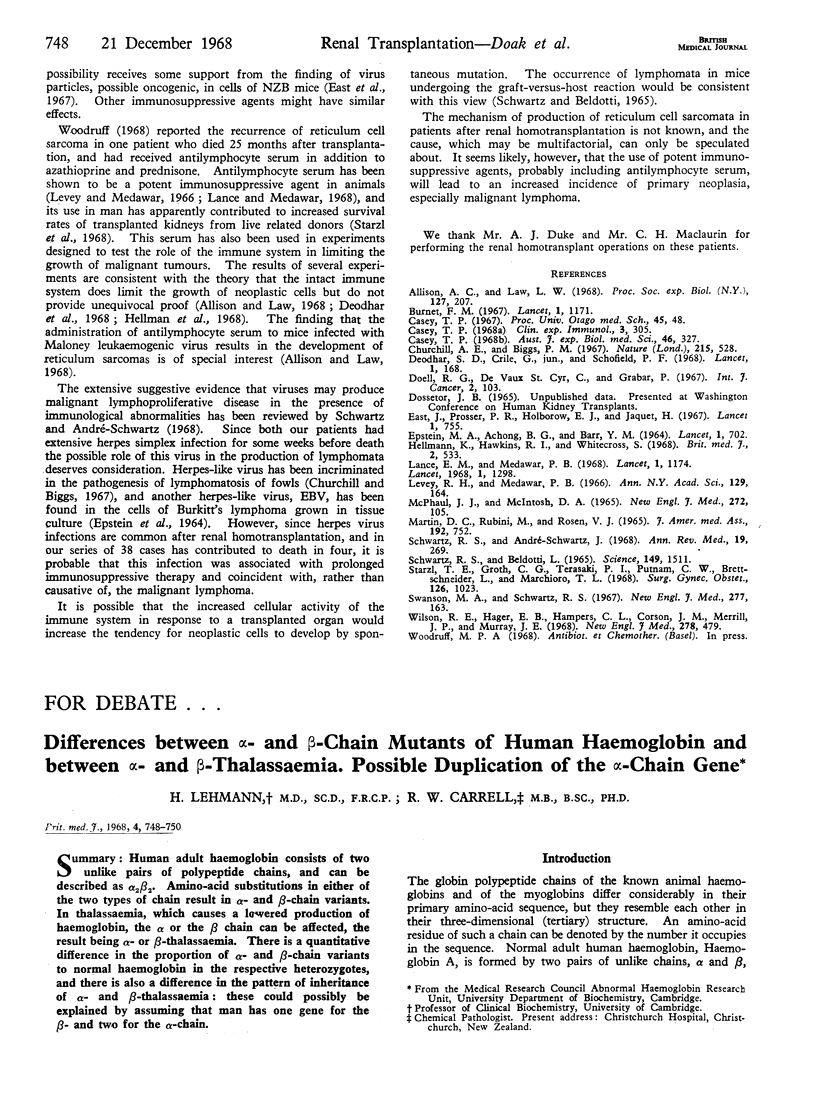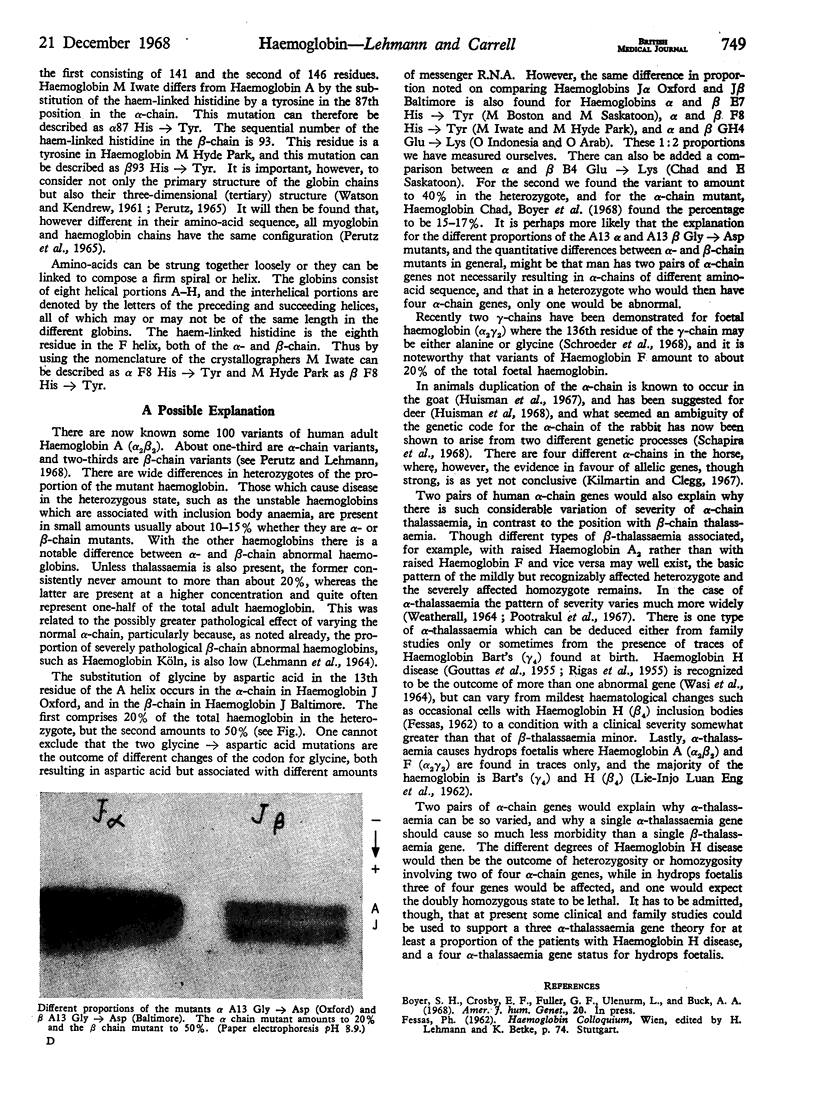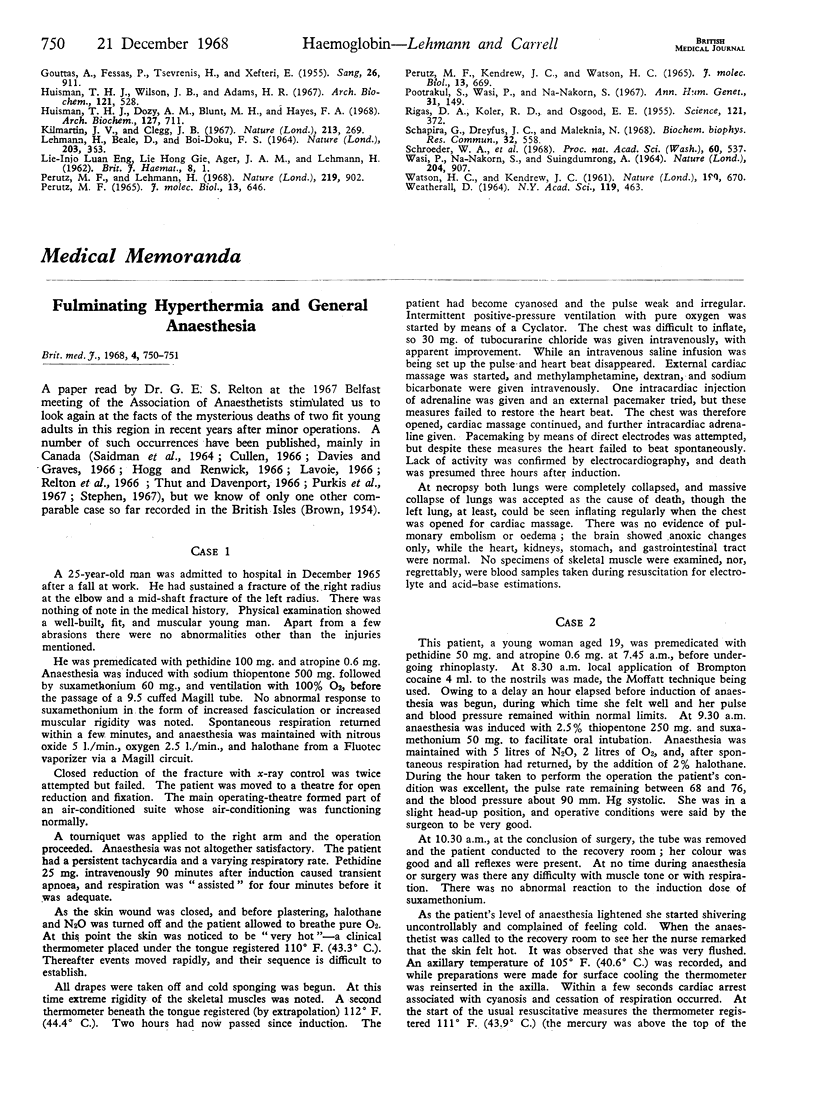Abstract
Human adult haemoglobin consists of two unlike pairs of polypeptide chains, and can be described as α2β2. Amino-acid substitutions in either of the two types of chain result in α- and β-chain variants. In thalassaemia, which causes a lowered production of haemoglobin, the α or the β chain can be affected, the result being α- or β-thalassaemia. There is a quantitative difference in the proportion of α- and β-chain variants to normal haemoglobin in the respective heterozygotes, and there is also a difference in the pattern of inheritance of α- and β-thalassaemia: these could possibly be explained by assuming that man has one gene for the β- and two for the α-chain.
Full text
PDF


Images in this article
Selected References
These references are in PubMed. This may not be the complete list of references from this article.
- GOUTTAS A., FESSAS P., TSEVRENIS H., XEFTERI E. Description d'une nouvelle variété d'anémie hémolytique congénitale; etude hématologique, électrophorétique et génétique. Sang. 1955;26(9):911–919. [PubMed] [Google Scholar]
- Huisman T. H., Dozy A. M., Blunt M. H., Hayes F. A. The hemoglobin heterogeneity of the Virginia white-tailed deer: a possible genetic explanation. Arch Biochem Biophys. 1968 Sep 20;127(1):711–717. doi: 10.1016/0003-9861(68)90281-6. [DOI] [PubMed] [Google Scholar]
- Huisman T. H., Wilson J. B., Adams H. R. The heterogeneity of goat hemoglobin: evidence for the existence of two nonallelic and one allelic alpha chain structural genes. Arch Biochem Biophys. 1967 Aug;121(2):528–530. doi: 10.1016/0003-9861(67)90111-7. [DOI] [PubMed] [Google Scholar]
- KENDREW J. C., WATSON H. C., STRANDBERG B. E., DICKERSON R. E., PHILLIPS D. C., SHORE V. C. The amino-acid sequence x-ray methods, and its correlation with chemical data. Nature. 1961 May 20;190:666–670. doi: 10.1038/190666a0. [DOI] [PubMed] [Google Scholar]
- Kilmartin J. V., Clegg J. B. Amino-acid replacements in horse haemoglobin. Nature. 1967 Jan 21;213(5073):269–271. doi: 10.1038/213269a0. [DOI] [PubMed] [Google Scholar]
- Perutz M. F., Lehmann H. Molecular pathology of human haemoglobin. Nature. 1968 Aug 31;219(5157):902–909. doi: 10.1038/219902a0. [DOI] [PubMed] [Google Scholar]
- RIGAS D. A., KOLER R. D., OSGOOD E. E. New hemoglobin possessing a higher electrophoretic mobility than normal adult hemoglobin. Science. 1955 Mar 11;121(3141):372–372. doi: 10.1126/science.121.3141.372. [DOI] [PubMed] [Google Scholar]
- Schapira G., Dreyfus J. C., Maleknia N. The ambiguities in the rabbit hemoglobin: evidence for a messenger RNA translated specifically into hemoglobin. Biochem Biophys Res Commun. 1968 Aug 13;32(3):558–561. doi: 10.1016/0006-291x(68)90699-2. [DOI] [PubMed] [Google Scholar]
- Schroeder W. A., Huisman T. H., Shelton J. R., Shelton J. B., Kleihauer E. F., Dozy A. M., Robberson B. Evidence for multiple structural genes for the gamma chain of human fetal hemoglobin. Proc Natl Acad Sci U S A. 1968 Jun;60(2):537–544. doi: 10.1073/pnas.60.2.537. [DOI] [PMC free article] [PubMed] [Google Scholar]
- WASI P., NA-NAKORN S., SUINGDUMRONG A. HAEMOGLOBIN H DISEASE IN THAILAND: A GENETICAL STUDY. Nature. 1964 Nov 28;204:907–908. doi: 10.1038/204907a0. [DOI] [PubMed] [Google Scholar]
- WEATHERALL D. J. RELATIONSHIP OF HEMOGLOBIN BART'S AND H TO ALPHA THALASSEMIA. Ann N Y Acad Sci. 1964 Oct 7;119:463–473. doi: 10.1111/j.1749-6632.1965.tb54047.x. [DOI] [PubMed] [Google Scholar]



